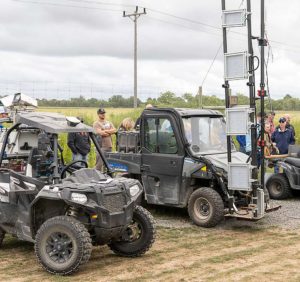—by Matt Milkovich

On a quest to improve soil health in New York state’s commercial apple orchards, Cornell University senior extension associate Deborah Aller and other researchers spent the past four years sampling, surveying and studying soil in orchards across the state. The long-term goal: to develop management recommendations growers can use to improve the health of their orchard soils.
But they’ve only begun to unravel the complexities of soil across such a large and environmentally diverse state, and many questions still need to be answered before they can develop recommendations for New York growers.
Aller shared some preliminary project findings during the International Fruit Tree Association’s annual conference in Rochester, New York, in February. She said the project received financial support from the New York State Soil Health Initiative.
Aller and Cornell extension colleagues collected soil and foliar samples from apple orchards across New York’s five major fruit regions — Lake Ontario, the Finger Lakes, the Champlain Valley, the Hudson Valley and eastern Long Island — encompassing a wide range of soil textures and environmental conditions. They focused on Honeycrisp, because of its known production issues, and collected soil from within herbicide strips, she said.

They also surveyed growers about their soil management practices. In general, New York growers utilize herbicides for weed control within the tree row, and few of them add organic matter back to the soil. But based on lessons learned from other cropping systems and preliminary project results, adding organic matter to the tree row is crucial to building healthier soils, Aller said.
She recommended growers reduce herbicide applications where possible, but she acknowledged that it’s “unrealistic” to ask growers to move away from herbicides completely.
“Growers do very well managing soil chemical properties,” Aller said. “They know how to manage nutrients, apply lime, things like that. But they struggle with physical and biological properties.”
On the biological side, the Cornell researchers discovered that almost 90 percent of the orchard soils they sampled contained plant-parasitic nematodes. However, initial analyses found no “clear relationship” between nematode population levels and impacts on soil health or overall fruit yield and quality, Aller said.

Future research is needed to uncover more about that relationship. It also will need to answer more fundamental questions: Which soil health indicators are the best predictors of fruit yield and quality? How do you connect management decisions with soil health outcomes?
Management recommendations, once developed, will have to be tailored to New York’s different regions and their particular soil and climatic conditions, she said.
The lack of firm answers to those questions has not stopped growers from exploring soil health practices, such as using cover crops before replanting.
During a panel discussion at the IFTA conference, Western New York apple grower Ted Furber described some of his soil management practices when renovating an orchard. Once the old trees are removed, he applies fertilizer and lime in early June, then he plants cover crops such as sorghum-sudangrass, cowpea or sunn hemp. In mid-September, he plants annual rye. The following summer, he applies more fertilizer if needed, plants more cover crops and discs the soil into 4-foot-wide strips to create new tree rows. He then plants tillage radishes within the strips, to suppress weeds until he’s ready to plant.

Aller said many growers want to know how previous land management might impact soil health in a new orchard planting. To study this, she grouped past land-use systems into three broad categories: direct replant from apples, annual cropping systems (corn, for example), and virgin soils. But those comparisons didn’t reveal an impact from previous land use on soil health, she said.
Aller and other Cornell researchers continue to collect soil samples from commercial orchards across New York. A new project this year aims to integrate canopy-level sensing data from drones with soil health data from New York orchards and vineyards, she said. •







Leave A Comment